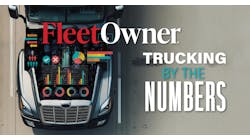Lindsey Trent is a firm believer that trucking companies can use technology to their advantage when it comes to recruiting and retention.
For Trent, who is president and co-founder of Next Generation in Trucking, a nonprofit that trains the next generation of trucking industry professionals through partnerships with high schools, community/technical colleges, and private schools, a clear indication was a recent study conducted by the Nebraska Trucking Association, American Transportation Research Institute (ATRI), University of Nebraska-Omaha, and Nebraska Trucking Foundation.
As part of the research on high school-age students’ career aspirations, feedback was solicited about advertisements promoting trucking careers. One of those focused on technology. For starters, almost all participants were surprised when they saw the inside of a modern truck. “They connected with technology,” the study report noted. “Many said this image might change people’s minds about a career.”
See also: Loss of technology jobs presents opportunity for trucking
In fact, responses from participants were even more direct:
- “Makes you think this career is still evolving, changing with new technology. Not a job of the past.”
- “For people who like tech, this opens the realm to them. Takes a higher skill to work it.”
- “Personally, I want a career with technology. This keeps trucking open to me. It just looks so comfy, and with the high technology it inspires me to have such a career and operate high-tech machines.”
- “The ad deviates from what most people think a truck looks like, showing that there can be more of a tech side of trucking, opening up the job to more people.”
“They have proven that GenZ is attracted to technology, so we’re using technology in our presentations to schools about careers in trucking,” Trent said. “And we’re telling our industry partners that technology on trucks, in shops, and in back offices can help recruit and retain a generation of tech-savvy people. If they connect the dots, they’ll see that the more the industry is tech forward, the less expensive it will be to get the help they need for the future, and the faster they’ll get a return on their technology investment as well.”
The value of digital technology
In her role as transportation adviser at Tenstreet, a software company that connects carriers and drivers throughout the driver life cycle, Marilyn Surber has firsthand experience with the value of digital technology. “Mobile-first technology is what a younger generation is looking for,” she said. “Using an app like Tenstreet’s Driver Pulse lets them complete tasks easily and streamlines the hiring process for both carriers and drivers.”
“If you expect a 23-year-old to fill out paperwork manually or spend a lot of time navigating your website, you will lose them,” added Surber, transportation adviser at Tenstreet. “In addition, you can customize your processes to meet the needs of different groups of drivers. A streamlined, modern, digital process sets the right tone from the beginning.”
See also: CarriersEdge releases new courses on personal security, mental health
With 15 years of experience in transportation, communications, recruiting, safety, and driver training, Surber also is a sought-after industry speaker. One of her recent appearances featured a presentation titled, “Look Out Trucking, the iGens are Coming!”
“Technology is one of the factors that unites and defines a generation,” Surber said. “And while Gen Y/millennials who were born between 1981 and 1996 are very technically savvy, it is Gen Z/iGen (1997-2010) who don’t know a world without the internet, who are addicted to and multitask on personal devices, and who spend eight to nine hours a day connected.”
Kevin Survance, CEO of Eleos Technologies, a provider of solutions that help trucking companies create custom mobile apps that give their drivers a unique work experience, said that effective communication strategies are essential to attract and retain younger generations.
“Fleets can do this by bringing ‘watercooler talk’ to drivers,” Survance said. “They can also regularly ask drivers for their feedback on a variety of relevant topics for their jobs and the business. Mobile technology makes collecting driver input easier than ever. With just a few clicks in a custom app, drivers can complete surveys or raise concerns about over-the-road working conditions, including instantly communicating with dispatch about interactions with customers and other trip-related details.”
See also: Current execs turn attention to trucking's next generation
“A study using our customer data also showed that workflow and communication apps that correlate to productivity gains add a minimum of 15 minutes of drive time per day,” he also reported. “For a fleet of 100 trucks, that amounts to an extra 25 productive hours daily. Furthermore, MIT research shows that an additional 18 minutes per day for every professional driver would be enough to overcome the current U.S. driver deficit.”
Central Oregon Truck Co. (COTC), a flatbed hauler of freight across the lower 48 states and Canada, was experiencing driver communication, recruitment and retention challenges that contributed to a turnover rate of around 94%. COTC attributed some of this trouble to a clunky web portal their drivers were using. With millennial drivers continuing to fill their ranks, COTC needed a system to meet the generation’s expectations without leaving older drivers behind.
To resolve these problems COTC worked with Eleos to develop a custom driver application that helped reduce driver turnover from 94% to 76%. Their drivers now use an intuitive, custom-made app on their smartphones and on the company’s in-cab tablets to automate trip management load workflows, document scanning, communications, voice navigation, and more.
Mobile tech crosses generations
Fleets can unite disparate systems and processes and give drivers a single interface to streamline daily trip planning and organize work, Survance noted. Tailoring the mobile experience to individual needs gives drivers the right tools for the job, where and when they need them.
“While the older generations are often somewhat wary of technology, they are increasingly recognizing its benefits,” said Chris Oliver, CMO at Trucker Path. “In fact, 65% of the community of Trucker Path users are over the age of 45, and nearly 40% are over 55. On the flip side, the younger generations have always relied upon technology and embrace it fully, so utilizing mobile devices and apps for handling business processes and even crowd-sourcing information or rating and reviewing facilities is second nature for them.”
The Trucker Path mobile app offers truck-optimized routing, information about truck stops, real-time parking availability, fuel prices, and weigh station statuses. Drivers also utilize the company’s TruckLoads digital freight exchange to source loads and connect with brokers. Recently, Trucker Path opened a new in-app digital marketplace featuring discounts and special offers on health care, insurance, accounting, and tax preparation products and services specifically tailored for drivers.
See also: New year's resolution: Listen to drivers
Mark Murrell, president of CarriersEdge, a provider of online driver training and the creator of the Best Fleets to Drive For program produced in partnership with Truckload Carriers Association, said that while there isn’t evidence that technology is inherently attractive to a younger generation, there is a strong detraction if it’s not there. “It’s more that they expect it and assume it’s there already,” he stated. “If the younger generation looks at a fleet and doesn’t see technology, that stands out as a negative.
Fleets can use technology to optimize and streamline all elements of recruiting and retention, however, they should really consider the complete experience of finding, onboarding, and ramping up drivers to a point where they’re successful in the fleet, Murrell noted. In a broader approach to finding and onboarding talent, technology plays a vital role.
The appeal of safety technologies
Fred Andersky, director of demos, sales and service training at Bendix, said it’s apparent that the industry needs to attract younger people into the driver’s seat and the shop. He points out as well how some of the latest and evolving technologies can be enticing for both drivers and technicians.
“Trucking is heavily involved in electrification and automated driving technologies,” Andersky stated. “There is an opportunity for younger drivers to contribute to the evolution of these new solutions. These developments also mean that more electronic systems [and] new drivetrains and power sources will bring opportunities for technicians to expand their skill level and expertise.”
Safety-based technologies like Wingman Fusion and Bendix ESP are among Bendix’s advanced systems and solutions for drivers and technicians today. The company’s ACom PRO diagnostic software helps technicians diagnose and repair braking system problems.
ZF Group has a full suite of advanced driver assistance systems (ADAS) that can be integrated with vehicle motion control systems, including ReAX adaptive steering technology along with OnTraX (lane keep assist). Its OnGuardMAX autonomous emergency braking system will launch in the third quarter of this year.
“The comfort and safety technologies available today open up career possibilities to a much broader demographic,” said Shaun Twomey, director of Americas strategy, market and sales, commercial vehicle solutions for ZF. “From the ease of steering to smoother automatic transmissions, and safety features that help enable drivers safely maneuver, truck driving is not what it was 10 years ago. The technologies enabling these features and benefits will help fleets recruit a new generation of drivers who would have otherwise never considered the career.”
Using tech to attract technicians
Modern diagnostic technologies can serve as both a recruiting and retention tool for younger technicians entering the workforce.
“Part of that is the technology they are provided at work,” said Jason Hedman, product manager at Noregon. “Consider electronic diagnostic applications. Are you using archaic methods that slow their work and reduce the number of trucks they can service during the week, or do you have modern tools that help them be more efficient?”
“At Noregon, we’re helping ensure that technicians are entering the workforce with the knowledge and resources to succeed,” he continued. “One way we accomplish this is by giving instructors free access to software their students will use in their careers, such as our JPRO and NextStep Repair solutions.”
As fleets and service providers look to attract new technicians, other advanced shop technologies will prove helpful. At Decisiv, for example, two integrations are bringing video inspection tools into the service management process for the more than 5,000 service locations and over 74,000 fleets using the company’s Service Relationship Management (SRM) platform.
See also: With new trucks scarce, fleets alter course to address tractor needs
In conjunction with Decisiv SRM, those facilities can incorporate the Quik video inspection solution. With the integration, technicians can make an unlimited number of videos and seamlessly include them directly in notes in case records. Decisiv has also integrated with TruVideo inspection videos to enhance communication and collaboration during service events. Access to videos using TruVideo technology is provided by simply attaching a link in the company’s SRM application.
At Velociti Inc., building the next generation workforce for its enterprise clients who focus on transportation and networking technologies is essential.
“We need highly skilled people to facilitate work on technologies using increasingly high-tech tools,” said Josh Webb, who heads up the company’s training center. “We’re investing in the knowledge and skills necessary to design, deploy, and support a wide variety of technologies for clients, the systems and solutions they rely on to operate effectively and efficiently.”
That investment includes training on diagnostic and other technologies and attracting a generation of people who find the high-tech nature of the work attractive.
“Technology is part of the natural progression of industry success, so we need people who see it as a growth path,” Webb stated. “There has never been a generation before that has had so much information at their fingertips, so as we move from mechanical systems to high-tech solutions, they are perfectly suited to take on those roles.”






